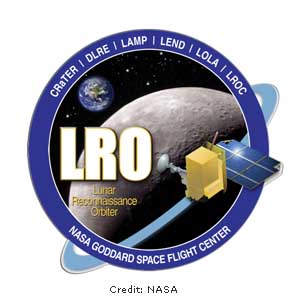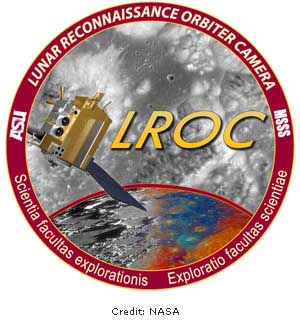Lunar Reconnaissance Orbiter
General information
The Lunar Reconnaissance Orbiter (LRO) is the first mission in NASA's Vision for Space Exploration, a plan to return to the Moon and then to travel to Mars and beyond. The LRO objectives are to find safe landing sites, locate potential resources, characterize the radiation environment, and demonstrate new technology.
The spacecraft will be placed in low polar orbit (50 km) for one year under direction of the NASA Exploration Systems Mission Directorate (ESMD), which oversees exploration technology development. LRO will return global data, such as day-night temperature maps, a global geodetic grid, high resolution color imaging and the moon's UV albedo. There is particular emphasis investigating the polar regions of the Moon, where there are areas continuously illuminated by the Sun and also areas lying in permanent shadow, where water ice might exist. Although the objectives of LRO are explorative in nature, the payload includes instruments with considerable heritage from previous planetary science missions. After the initial one-year mission, the orbit will be modified and will transition to a science phase under the NASA Science Mission Directorate (SMD)Instrument
The Lunar Reconnaissance Orbiter Camera (LROC) is designed to address two of the prime LRO measurement requirements: 1) Assess meter-scale features to facilitate selection of future landing sites on the Moon, 2) Acquire images of the poles to characterize the polar illumination environment (100-meter scale), identifying regions of permanent shadow and permanent or near-permanent illumination over a full lunar year.
In addition to these two main objectives, the LROC team plans to conduct meter-scale mapping of the polar regions, make 3-dimensional observations to enable derivation of meter-scale surface features, perform global multispectral imaging, and produce a global landform map. LROC images will also be used to map and determine current impact hazards by re-photographing Apollo image areas.
LROC consists of two Narrow Angle Cameras (NACs) to provide 0.5 meter-scale panchromatic images over a 5 km swath, a Wide Angle Camera (WAC) to provide images at a scale of 100 meters/pixel in seven color bands over a 60 km swath, and a Sequence and Compressor System (SCS) supporting data acquisition for both cameras. LROC is a modified version of the Mars Reconnaissance Orbiter’s ConTeXt Camera (CTX) and MARs Color Imager (MARCI) provided by Malin Space Science SystemsOfficial LROC Websites:
http://www.nasa.gov/mission_pages/LRO/main/index.html
http://lroc.sese.asu.edu/index.html
NASA LROC Factsheet
NASA LRO/LCROSS Press Kit
NASA LRO Paper Model

Instrument
The Lunar Reconnaissance Orbiter Camera (LROC) is designed to address two of the prime LRO measurement requirements: 1) Assess meter-scale features to facilitate selection of future landing sites on the Moon, 2) Acquire images of the poles to characterize the polar illumination environment (100-meter scale), identifying regions of permanent shadow and permanent or near-permanent illumination over a full lunar year.
In addition to these two main objectives, the LROC team plans to conduct meter-scale mapping of the polar regions, make 3-dimensional observations to enable derivation of meter-scale surface features, perform global multispectral imaging, and produce a global landform map. LROC images will also be used to map and determine current impact hazards by re-photographing Apollo image areas.
LROC consists of two Narrow Angle Cameras (NACs) to provide 0.5 meter-scale panchromatic images over a 5 km swath, a Wide Angle Camera (WAC) to provide images at a scale of 100 meters/pixel in seven color bands over a 60 km swath, and a Sequence and Compressor System (SCS) supporting data acquisition for both cameras. LROC is a modified version of the Mars Reconnaissance Orbiter’s ConTeXt Camera (CTX) and MARs Color Imager (MARCI) provided by Malin Space Science Systems (MSSS) in San Diego, CA.
Official LROC Website:
http://lroc.sese.asu.edu/index.html
NASA LROC Factsheet (english)
NASA LROC Factsheet (deutsch)

